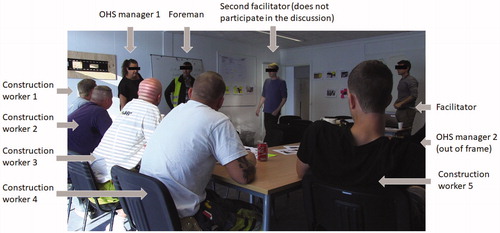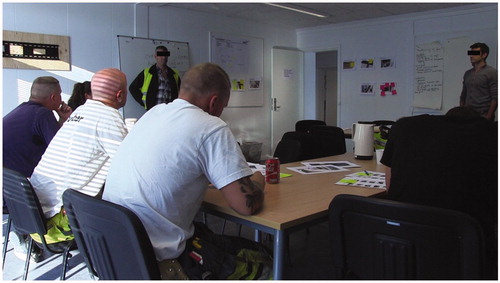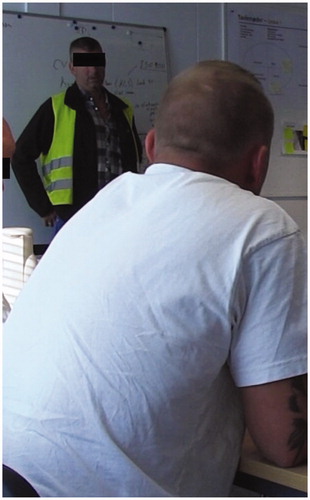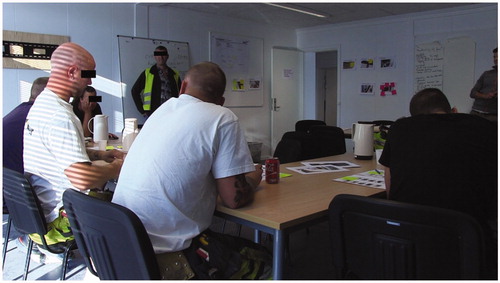Abstract
Participatory designs are regarded as a positive way to develop and execute organisational health and safety interventions in the construction industry. While most studies focus on effect measures, little is known about process-related factors shaping the outcomes of interventions. In this article, the authors suggest that success in implementing organisational interventions is tied to microsocial mechanisms that affect whether engagement and creativity materialise into improvements. In this regard, interaction within intervention activities has been overlooked as relevant data sources. To exemplify how these may be useful, video-recorded interactions between participants in an intervention workshop setting are analysed. The framework focuses on threats to the participants’ face (i.e. their public self-image), the participants “facework”, and on how social action is oriented to deontic, epistemic and emotional domains of order. The analysis shows how threats to the participants’ faces arise in interaction, diverting the focus of discussions away from the aim of the workshops; developing initiatives to improve employees’ health and safety. The analysis highlights that participatory interventions may be ineffective if potential face threats are not mitigated and managed actively. We suggest that the manager-facilitator-employee communicational design should be an area of increased focus.
Introduction
Participatory designs are widely regarded as a positive way to develop and implement organisational interventions concerning occupational health and safety (OHS) and have long been recommended by both international bodies and researchers (ILO Citation2001, MacKay et al. Citation2004, Rivilis et al. Citation2008, van Eerd et al. Citation2010). This is also the case in the construction industry (e.g. Lingard et al. Citation2015, Dale et al. Citation2016, Brandt et al. Citation2018).
The participatory elements of organisational interventions have been described as important to ensure the relevance of interventions through the engagement of practical experiences and know-how from different parties – e.g. employees, managers and intervention experts (Kompier et al. Citation1998), and to promote engagement and ownership over change processes by involving employees (Rosskam Citation2009). It has been shown that employee influence in interventions is linked to the uptake of organisational intervention activities (Nielsen et al. Citation2007), as well as post-intervention autonomy, social support and well-being (Nielsen and Randall Citation2012). In the construction industry, participatory approaches have been applied to the implementation of OHS initiatives with various degrees of success. For instance, Lingard et al. (Citation2015) show that participatory video techniques may assist in creating engagement and creativity in developing solutions for OHS problems, among both workers and managers (2015). However, several studies show that participatory interventions do not always deliver these positive outcomes. Both Brandt et al. (Citation2018) and Dale et al. (Citation2016) have recently reported high levels of engagement but no changes in physiological symptoms (pain and physical effort) as a result of participatory interventions among construction workers. Therefore, it is important to understand the microsocial mechanisms in participatory interventions that may prevent engagement and creativity from leading to OHS improvements (e.g. Reduced physiological symptoms).
A number of process-related factors complicate our understanding of what’s going on in participatory organisational interventions. Recent studies among construction workers show that several factors pose challenges when developing OHS solutions, e.g. the participating employees’ social identifications with team members rather than the organisation, time pressure, economic incentives, working-class masculinity and habituation of pain (Ajslev et al. Citation2013, Lingard Citation2013, Andersen et al. Citation2015). These studies, however, perceive workers’ and managers’ stances towards OHS development as driven by their personal resources, past experiences in the organisation, and expectations about the future (Nielsen et al. Citation2007). Less focus has been paid to the micro-social order and emergent character of participatory OHS processes in construction work as they play out in situated activities, that is, where the “action” of participatory interventions take place.
Understanding how the situated social order is negotiated is a central concern in the micro-sociological tradition (Garfinkel Citation1967, Goffman Citation1982, Sacks Citation1995), which has demonstrated how people are continuously oriented towards the socio-affective aspects of ongoing activities – including work interactions (Llewellyn and Hindmarsh Citation2013), and how this orientation shapes the trajectory of the interaction and thus its outcomes. Particularly central to the socio-affective character of interaction is the concept of face, that is, one’s social regard or positive social value in the setting (Goffman Citation1982, Lerner Citation1996).
This article investigates how concerns about saving or losing face plays a part during a critical sequence of a participatory workshop, conducted as part of an organisational intervention concerning OHS among construction workers, and how the participants navigate the overt and potential threats to their public selves. In this endeavour, we employ the concept of facework (Goffman Citation1982) in a conversation analytical inspired framework of how human interaction is “anchored”, not just in an emotional order, but also in deontic (power-related) and epistemic (knowledge-oriented) orders (Stevanovic and Peräkylä Citation2014).
Based on the analysis, we suggest that future participatory- and implementation research in the construction industry and elsewhere will benefit from an increased focus on how micro-sociological dynamics can improve both participatory and communicative design, as well as the interaction between managers, facilitators and employees. In addition, we contribute to the scarce literature on social relations in the construction industry by exemplifying how negative communication and contradictory relationships between managers and employees can be counterproductive to OHS development and by suggesting paths for remedying this.
Participatory interventions
The engagement of – and communication among – different stakeholders in participatory processes is a frequently discussed concern when designing participatory interventions and processes. One challenge is that including managers in the participatory process affects the voice of employees, and that direct decision making and emancipatory potentials may thereby change drastically (Beirne Citation2008). This pose a dilemma as managers may be needed to provide the necessary resources – e.g. time, economy, materials – to make actual changes. Another challenge in handling the interests of different stakeholders is that participatory change processes may be delegated from upper management, who initiate the participatory process, to lower level managers or workers. This can contribute to a lack of shared organisational understanding for identified challenges and solutions because higher level management has not participated in intervention activities (Strumińska-Kutra Citation2016). On the other hand, Mikkelsen argues that in a participatory environment, managers and employees may act as co-learners in an empowerment process (Citation2005). These arguments explain important aspects of why participatory organisational interventions may at times succeed or fail.
In recent research calling out for a better understanding of process-related factors with an impact on the success of organisational interventions, it has been emphasised that effective communicational practices within organisational interventions are imperative to success (Nielsen et al. Citation2010). Nielsen et al. briefly revisit the fact that communication influences how people make sense of events and eventually buy into them (p. 227). However, we found that particularly the aspect of communication in intervention processes is somewhat under-developed in contemporary intervention designs and research. Rosskam describes that “applying participatory action research requires ensuring that those participating in the research feel that the researchers have genuine respect for them and their experiences, that their opinions are valued, and that they are perceived as partners in the process” (Rosskam Citation2009). Other research methodologies set up a number of rules for conversation in different phases of workshops or conferences. These rules are developed with the aim of securing openness, creativity and engagement from participants and are based on principles for democratic dialogue (Gustavsen and Engelstad Citation1986). Even though conversational practices are discussed in some methodological texts, these do not explicitly describe the important potential gains or risks to the participants and to the organisational intervention process which is connected to the conversation in the participatory processes. We suggest that development in organisational interventions may benefit from a more explicit focus on the meaning and consequences of conversation-sequences as decisive in the outcome of participatory organisational interventions.
Face-work and three orders in the organisation of human action
Within construction research, studies founded in the micro-sociological tradition are rare. However, Mogendorff (2016) has suggested that applying this type of ethnomethodological or performative approaches may be of relevance to better understanding how expertise emerges and conflicts may be managed. Also, Gluch and Räisänen (Citation2009) suggest that an increased focus on communicational practices may be a relevant step to address mismatches between policy and action within construction projects. As described, one particularly relevant characteristic to understanding communicational interaction within the micro-sociological approaches is the concept of face.
In his seminal work, Interaction Ritual, Erving Goffman unfolds the concepts “face” and “facework”. His main point is that in every human interaction, people enact a “line”. A line may be defined as; “a particular pattern of verbal and nonverbal acts through which he expresses his view of the situation and through this his evaluation of the participants especially himself” (Goffman Citation1982). A person’s “face” is tied to the line as the positive social value one can effectively claim for oneself through the line that others assume one has taken – and allow to remain unchallenged. People are most often emotionally committed to the face, they are able to claim in a given context, and this is tied to their sense of self-esteem and self-value. In other terms face could be explained as the identity one seeks to assume for others to accept, whereas “line” is the things that one does to maintain face. For instance, construction workers will often positively assert themselves and others through what has been termed “traditional working-class masculine traits”; self-reliance, strength, endurance, being professionally skilled, performing as a family provider and habituating pain (Wolkowitz Citation2006, Thiel Citation2012, Ajslev et al. Citation2013, Citation2016). If these identifications or “faces” become threatened in conversation, people experience a risk of losing face and with it their social value, self-esteem and self-value. Therefore people most often try to maintain their own face, while taking care not to challenge others’. A person maintains his or her face when the lines, they enact, are accepted by others. As long as a person remains in face, the person can be expected to feel comfortable. On the other hand, a person can be described as being in wrong face when they are spoken down to, down about or against. If the situation is not remedied, this person will often feel anxious, ashamed, embarrassed or in other ways bad.
When their face is challenged, people use face-saving practices to remedy the situation. They, for instance, avoid contact that could lead to challenges, but also withdraw or disengage from discussions, keep off topics that might reveal information that would be inconsistent with the face they want to maintain, or they will try to change the topic of conversation. Social convention will invite people to interfere in face-threatening situations and support the line of the one whose face is threatened. In this sense, studying face and face-work is to study norms and rules for social interaction (Goffman Citation1982).
Although widely recognised, the concepts of face and face-work have been criticised for being hard to pinpoint in analysis, thus becoming a product of the analyst’s intuitive interpretation, rather than the visible concerns of parties in interaction (Lerner Citation1996, Samra-Fredericks Citation2010). In order to make up for this methodological challenge, both Lerner and Samra-Fredericks employ a conversation analytical (CA) approach to identify when interlocutors’ face concerns become visible in interaction. One key principle of CA is the “next-turn-proof procedure” (Schegloff and Sacks Citation1973). This procedure refers to the phenomenon that recipients, when spoken to, will typically display their understanding of the previous turn(s) of talk in their response. When employed in analyses of facework it becomes possible to identify and describe participants’ changing concerns on a turn-by-turn basis. Basing analyses of interaction on the next-turn proof procedure as a preliminary step (Schegloff Citation1997) offers a strong validity by keeping the main analytical focus on observable events of the conversation that participants orient themselves towards on following turns in the conversation. In this way, it becomes possible to decipher how utterances in the workshop are treated as either face-threatening or -saving.
An important resource for CA studies of face is the fact that interlocutors generally display a strong preference for agreement with the preference structure of what is being said (Sacks Citation1987). This structure does not refer to agreeing on the topic of what is being said, but with the expectations about upcoming responses designed into utterances. For example, “will you make it tomorrow?” projects acceptance of the request, while “you won’t be able to make it tomorrow, will you?” projects a declination of the request, but an acceptance of the speaker’s assessment, and thus a “preferred” response. Speakers typically design their turns to elicit preferred responses. Furthermore, preferred responses in interaction are typically provided in an unmarked and unmitigated fashion, while dispreferred responses are delayed or mitigated (Pomerantz Citation1984). When such delays and mitigations are present, or when respondents fail to display an understanding of the preference structure of the original utterance, this is typically taken by interlocutors as face-threatening (Lerner Citation1996). Pomerantz (Citation1986) further provides the argument that extreme case formulations –situations in which interlocutors maximise of minimise the meaning of phenomena (invoking terms such as “always” “never”, “everything” or “nothing”) – should be perceived moves intending to create undisputable legitimacy regarding their claims. Such situations are also important as they indicate that something is at stake.
Another relevant concept for analysing the role of face in interaction is based on the observation that people pervasively orient themselves towards three interactional orders: the epistemic, deontic and emotional orders (Stevanovic and Peräkylä Citation2014). The epistemic order regards topics in which the participant has rights to- and can be expected to know about in relation to the other participants. Every time someone in conversation indicates what he or she knows or thinks that others know or do not know, she can be perceived as speaking in relation to the epistemic order. The deontic order addresses the participant’s rights or capability to force other participants to submit to actions or demands. As such, this has to do with power, control, and asymmetric power-relations that unfold in conversation. This is made visible when the speaker asks for actions, make decisions and enact actions. Deontic status has to do with the participants’ common history and their relative positions in societal and organisational structures. The emotional order is about emotions that participants are allowed to or expected to express in relation to others. This has to do with emotion, affection, and involvement. In this regard, there are certain social conventions in all social contexts. As a relevant example, professional roles are most often tied to an “affective neutrality” (Stevanovic and Peräkylä Citation2014). Upholding the emotional order is an important part of being perceived as a moral member of society and/or the group. Emotional status refers to the socially shared expectations that participants have towards a person based on their mutual experience and on that person’s position in a certain domain of experience. Emotional status can be expressed verbally and nonverbally. Here, language use, grammar, posture, and facial expressions matter when studying bodily expressions of emotions in interaction (e.g. Local and Walker Citation2008, Ruusuvuori Citation2007, Citation2012, Peräkylä and Sorjonen Citation2012). For example, a slumping bodily posture can indicate an orientation to potentially having lost face (Goffman Citation1982, Clift Citation2014). For each of the three orders, participants in interaction can be said to take a certain stance and hold a certain status: a person’s stance is the way they present themselves – in facework-terms. It is parallel to the line a person is taking in particular conversation, hence we employ the stance concept in the analysis. A person’s status refers to the position a participant is oriented to as holding within a particular order and is thought to be based upon the person’s personal history shared with the others in conversation. Thereby, the way interlocutors position themselves relative to each other in relation to the three orders functions to negotiate their relationship as symmetrical or asymmetrical. For persons with a low status in some order relative to their co-participants, being met with acts which level out asymmetry are usually oriented to as face-saving while acts that emphasise the relational asymmetry are taken as face-threatening (Stevanovic Citation2015). Typically, there is a high level of consistency between status and stance within the three orders. However, this is not always the case.
It should be noted that in order to make sense of what others are attempting to do in interaction and respond appropriately, interlocutors rely on both sequential elements of talk (such as the next-turn proof procedure and preference) and the epistemic, deontic and emotional orders. For example, declaratives (e.g. “he got the job”) are typically understood as assertions if the speaker is perceived to hold a higher epistemic status in relation to the subject than the recipient, and as questions if the statuses are reversed (Heritage Citation2012). This means that it is also analytically relevant to attend to how these various aspects of the interaction come together in shaping the turn-by-turn-development of specific sequences.
Therefore, in order to show what risks are related to loss of face are undertaken by participants during the workshop, the analytical framework, we employ, focuses on the participants’ orientations to face as they become visible through the next-turn proof procedure, how preference structures are set up and responded to, and how their relative statuses within the three orders are negotiated.
Methods
For this study, we draw on empirical material collected as part of a research project, which followed a participatory organisational intervention targeting physically straining work-tasks in the Danish construction industry. The methods for the full intervention study can be consulted in (Brandt et al. Citation2015).
In brief, the participatory programme consisted of three workshops held approximately one month apart. The workshops were organised in a three-phase structure inspired mainly from action research (Nielsen and Svensson Citation2006). A total of 80 male full-time construction workers (aged 19–67 years) were randomised at the cluster level (gang) to an intervention consisting of three workshops (seven gangs and 32 workers) or to a control group (eight gangs and 48 workers). All were ethnic Danes. In total, 19 workshops with a total of 32 participating construction workers, four foremen and seven OHS managers were video recorded for subsequent analyses except for two workshops which, due to technical malfunction, were only audio recorded. Approximately 29 hours of workshop material was produced. The participants were recruited in collaboration with the construction industry’s safety and health preventive service, and were from some of the largest construction entrepreneurs in Denmark.
The first workshop, one of which our material is from, was designed with inspiration from the future workshop concept, which usually also consist of three phases: (1) critique, (2) utopia and (3) realisation. In our design, however, the critique phase was replaced by a phase where the most physically strenuous tasks – based on technical measurements and video recordings – were presented to the participants, and the participants were encouraged to decide which tasks they would like to work towards modifying over the course of the intervention. In the utopia phase, the participants discussed the selected work tasks with exclusive focus on how the tasks could be carried out in the best of all worlds. In the realisation phase, participants were asked to consider possibilities and barriers to reach the utopias and to write down an action plan.
In the ensuing analysis, we focus on a particular sequence of interactions occurring within a longer workshop. Attending the workshop were two researchers who facilitate the workshop as well as author the article, OHS manager I and II, concrete worker I–V and finally, there was the concrete foreman, who initially planned to participate in the workshop, but had to work elsewhere on the site just as the workshop was about to start. The focal stretch of interaction comprises foreman’s return to the workshop room.
Attendants:
Facilitator/researcher I
Researcher II
OHS manager I
OHS manager II
Foreman
Construction worker I–V
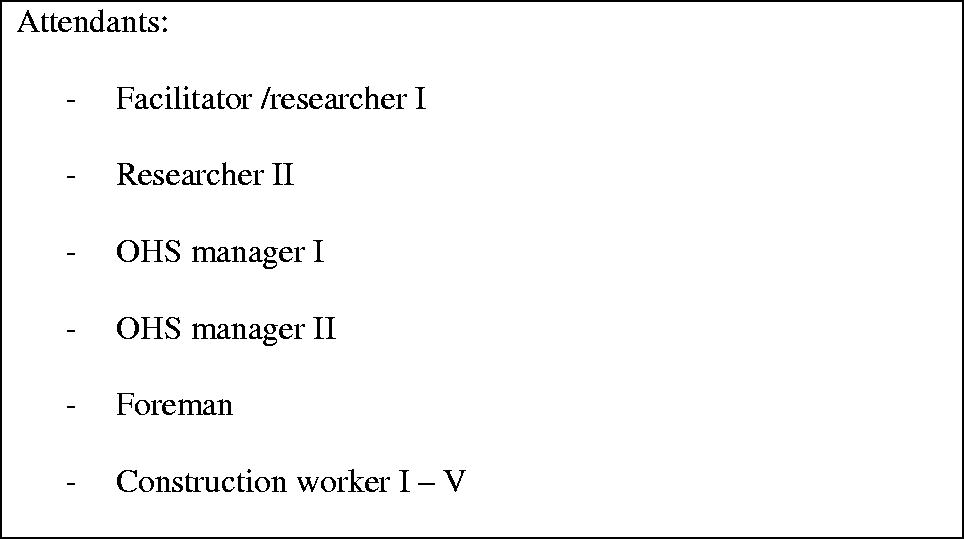
The chosen case is scientifically relevant in two ways. First, the excerpt is relevant because it shows what we would call a turning point in the workshop, i.e. a situation that has a critical impact on the outcome of the intervention process as a whole. These, often brief, situations happen in all types of participatory processes, and we argue that more attention should be paid to these in intervention research. The other sense in which the excerpt is relevant, is as a paradigmatic case (Flyvbjerg Citation2006) on employee-manager relations in the construction industry, which can provide theoretical insights relevant for understanding similar situations in these types of settings in general. Thiel (Citation2012) exemplifies this relation when describing how many workers perceive managers as disrespectful in their very direct form of delegating work through orders rather than requests, and in failing to acknowledge the workers’ knowledge and skills. This relationship has recently been described as an “us and them relationship”, where construction workers identify themselves in opposition to their managers and employers (Paap Citation2006, Thiel Citation2012, Andersen et al. Citation2015).
The analysis was developed through repeated, focussed viewings of the video recording, noting analytical points in relation to an iterative working transcript (Mondada Citation2007). These analytical points were discussed in relation to the relevant literature on facework, leading to development of the analytical framework presented earlier. Throughout the analysis, we employed both a focus on how the interaction was organised in turns based on the next-turn proof procedure and how the social dynamics within the interaction could be further elucidated by considering the extant literature on facework in interaction. We also attended to the participants’ bodily expressions (such as gaze, nodding and posture) in certain parts of the sequence where these expressions seem particularly relevant for the way the interaction progresses. It should be noted that we do not apply a strict CA approach, as we do in some places draw on theory and contextual knowledge to substantiate claims.
While the analysis was performed on the Danish-language data, the data has been translated into idiomatic English for presentation here. The transcriptions follow the Jefferson style conventions (Jefferson Citation2004), which enable notation of various relevant details about how things are said and responded to, such as pauses, overlaps and words uttered with emphasis.
Analysis
Before this particular sequence, the participants and facilitating researchers had been engaged in identifying tasks which required particular physical exertion and discussing possible ways to reduce this exertion. The participants decided to focus on the issue of having to use heavy steel shuttering (shuttering – the mold) when casting concrete, where especially assembling the shuttering required heavy manual work. Before the selected sequence Construction worker I and Construction worker IV related first-hand experiences using aluminium shuttering, which, according to them, reduces physical exertion compared to steel. Supported by the researchers and OHS managers, the topic was discussed for approximately 20 minutes during which several participants expressed positive expectations towards the ability of aluminium shuttering to reduce exertion. However, Construction worker IV and Construction worker III also expressed that “the high lords” (top-level management) would not support the idea, as it could be costly. At this point, the researchers and OHS managers encouraged the participants to continue their engagement with the idea so that an action plan concerning potentially implementing the solution could be developed. However, before the plan was developed, one of the OHS managers energetically left the room to engage the site foreman in the discussion.
In the following excerpts, we see the foreman’s response to the employees and follow the ensuing discussion.
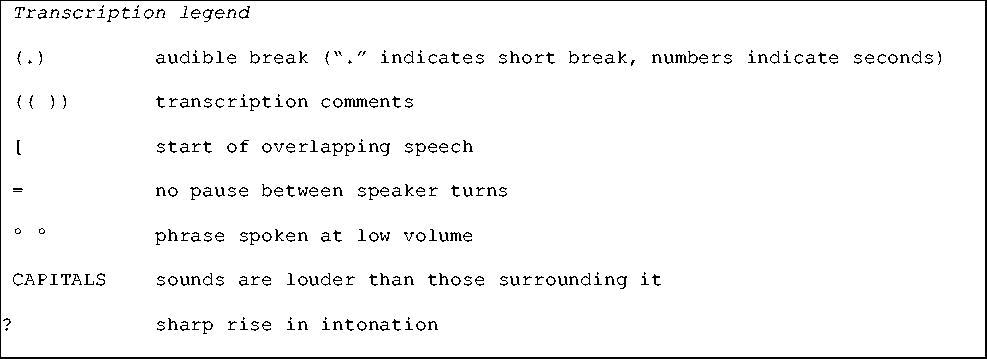
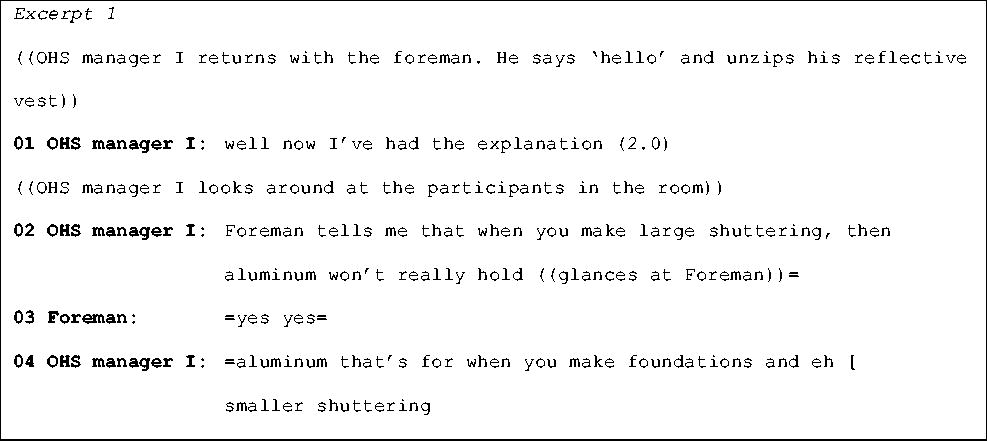
OHS manager I reports having received an “explanation” from Foreman outside the workshop room (turn 1). She expresses that the explanation is founded in practical knowledge and the material character of aluminium shuttering that the rest should now hear. At the end of her turn, OHS manager I turns her gaze towards Foreman. One common function of gaze is to direct the selection of the next speaker (Lerner Citation2003), and here, the glance is taken by Foreman as a request for confirmation which he produces. OHS manager I continues, reporting the explanation, describing aluminium as reserved for other tasks than the one discussed by the employees. At this point, the conversation sorients towards the epistemic order, where knowledge about the practical work is of central importance (Stevanovic and Peräkylä Citation2014). OHS manager I takes a downgraded epistemic stance through her initial utterances and alignment check towards Foreman, which positions him as holding a superior epistemic status to the other participants. Thus, by being formatted as an account for why the aluminium solution is inadequate, the “explanation” functions as a mitigated rejection of the suggestion. Such accounts are important as those who fail to provide them when rejecting a suggestion may be viewed as “hostile” or “careless of the face” of their co-interactants (Heritage Citation1988, p. 138). However, in order to be face-saving for the recipients, the account must warrant the rejection by referencing inapplicability, rather than simply unwillingness – what Heritage calls a “no-fault” account. Here, the claimed inappropriateness of aluminium shuttering is designed as such an account. Still, the claimed inappropriateness poses a potential face challenge to the workers – in particular Construction worker I and Construction worker IV, because it opposes their earlier epistemic stances as experienced and knowledgeable about employing aluminium for similar tasks. At the same time, the first turn also refers to OHS manager I having had an explanation to a question, and judging by the answer, she must have asked something along the lines of” why are we not employing aluminium shuttering? “This means that already at this point, the foreman may have experienced a challenge to his epistemic stance of being a “capable work leader and decision maker”, putting his face at stake.
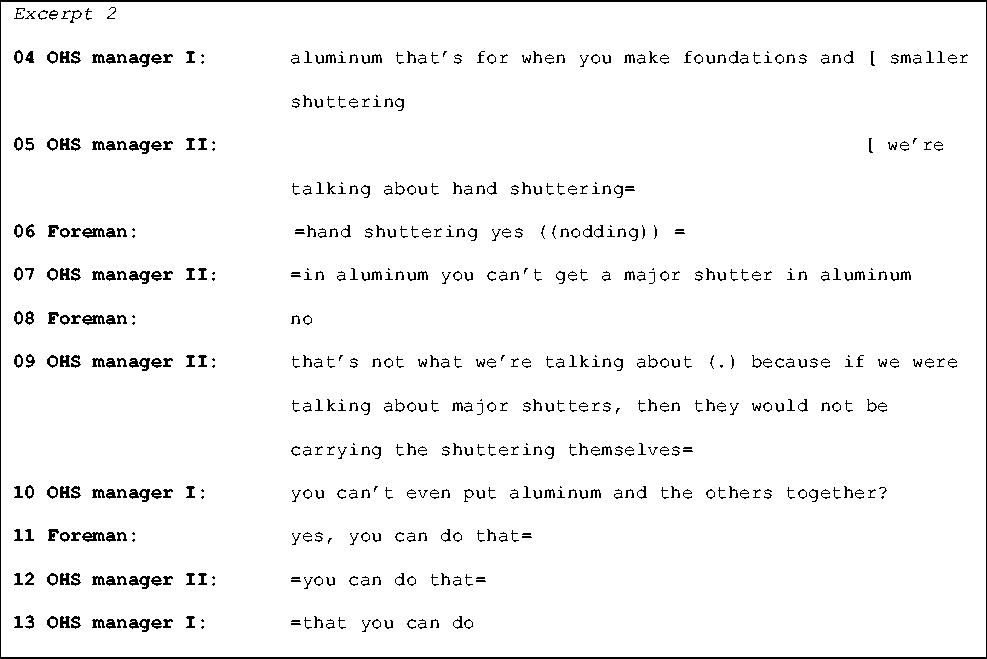
Turn 5 sees OHS manager II, the other OHS manager, formulate what is being talked about as “hand shuttering”, partly in overlap with OHS manager I’s report. OHS manager II’s turn is oriented to by Foreman as a request for confirmation, which Foreman answers in line with its implied preference: that OHS manager II’s explanation is on-topic. As an additional note, Foreman’s nodding here occurs simultaneously with his utterance, which is likely to be taken as emphasising his response (Aoki Citation2011). Thereby, Foreman confirm the allusion in OHS-manager II’s question that Foreman’s critical stance towards the employees’ suggestion is caused by a misunderstanding. As such, OHS-manager II challenges the epistemic soundness of the reported explanation, but in a mitigated way that also displays an orientation to Foreman’s face. At the same time, OHS-manager II is providing a defence to the workers’ faces – as skilled and knowledgeable workers – through his epistemic correction or specification of the topic (turn 9). This also maintains the relevance of the aluminium solution to reducing physical exertion.
The reference to “hand shuttering” in turn 5 introduces a different distinction to the interaction than OHS manager I’s “large” and “smaller shuttering” (excerpt 1), instead focussing on how the shutters are handled. In contrast with “hand shuttering”, OHS manager II in turn 7 asserts the unavailability of aluminium major shutters (a type of shutter which can only be moved by crane), which Foreman confirms – thus supporting OHS manager II’s epistemic stance as knowledgeable in the matter – and OHS manager II continues to describe how major shutters would be off-topic due to not being strenuous to work with, as they cannot be manually handled. Besides providing a defence to the workers’ faces, OHS manager II’s specification potentially becomes a challenge to Foreman’s face, as OHS manager II questions the epistemic soundness of the explanation provided on his behalf by OHS manager I.
Next, OHS manager I asks about the possibility of combining aluminium and steel, and while the question format projects a negative response, the possibility is acknowledged by Foreman and OHS manager II. This underscores OHS manager I’s low epistemic status on the matter.
Already at this point, more is going on than the discussion of when, and for what, aluminium shuttering can be used. The foreman’s initial epistemically based claim has been put into question by OHS manager II’s specifications, potentially challenging the foremans face, as the ensuing analysis will further clarify.
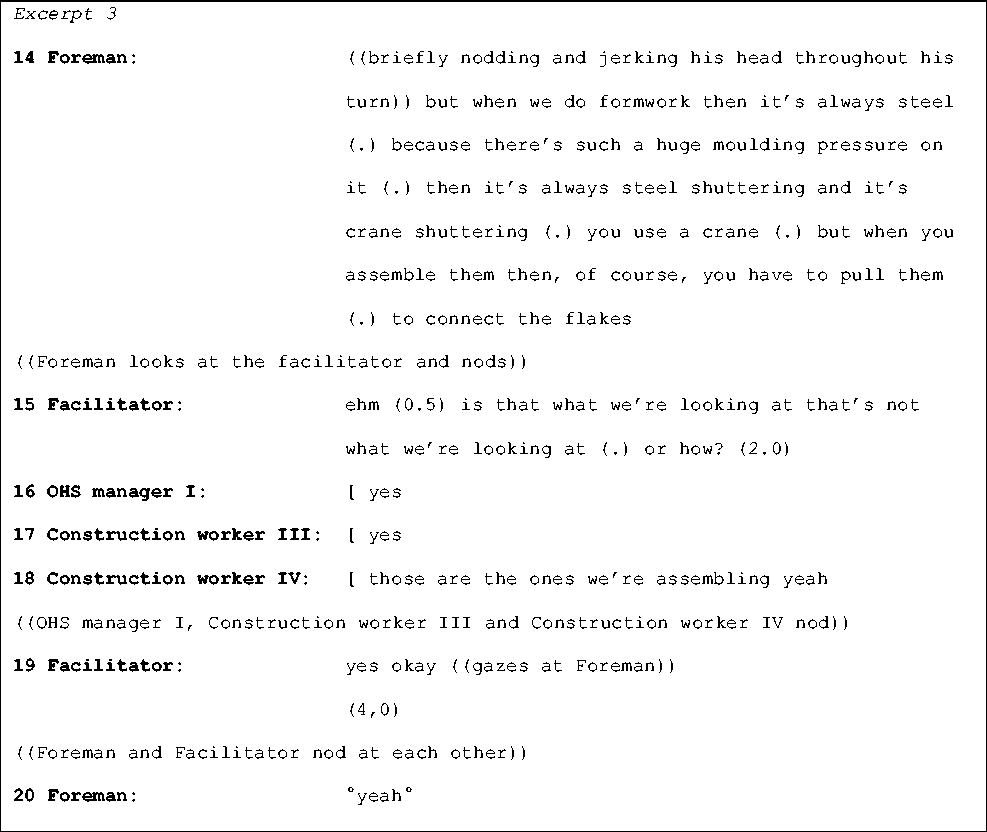
After having confirmed in the previous extract that combining aluminium and steel was possible, Foreman asserts that steel shuttering is “always” used in “formwork” and provides an account for why (turn 14). He describes the shuttering in use as a “crane shuttering” (in contrast to OHS manager II’s “hand shuttering”), thereby highlighting the crane’s contribution to the task, while only describing one physical (and thus potentially exerting) aspect of the task (“connecting the flakes”). Thereby, the employees’ assessment of the task as strenuous is downplayed, although we cannot say whether this effect is intentional, or whether it is picked up by the other participants as a deliberate “move”. Foreman also refers to a “usual practice” (“when we do formwork”), which is a conversational move tying together the deontic and epistemic orders, as usual practice may be founded on both the best available knowledge but may also be an invocation of a norm for practice. He then connects this to the epistemic claim about steel being able to handle a higher level of pressure. The foreman’s deemphasizing of the physical aspect is both a diversion of the original discussion – implying that Foreman is defending his face as a capable foreman (Goffman Citation1982) – and a challenge to the employees’ and other participants’ assessment of the task as strenuous, and thus to their face. His recognition of the employees’ project is a minimal extreme case (Pomerantz Citation1986), but arguably visible in Foreman’s formulation “of course you have to pull them” – an inference to the employees’ concerns since this part of the task has not been mentioned as strenuous while Foreman has been in the room. Thus, his emotional stance towards the employees could be described as distanced. However, he seeks to maintain a superior epistemic stance by his use of extreme case formulations (“it’s always steel”, “it’s always steel shuttering”) and unmarked assertions about how the work is performed (“it’s crane shuttering”).
Furthermore, nodding at the other participants at the end of one’s turn, as Foreman does here, is typically taken as a request for an indication of agreement (Heath Citation1992, McClave Citation2000). By turning and nodding towards the facilitator, Foreman next projects him as the upcoming speaker. These actions imply the upgraded deontic stance Foreman is taking by seeking to pace the discussion towards a termination, and thus a rejection of the employees’ suggestion.
The facilitator takes his time, showing some discomfort in this selection by the initial” ehm”. Then on turn 15, the facilitator displays some confusion over both the correctness of the foreman’s statement, and the topic of conversation. The foreman’s selection of the facilitator as next speaker is responded to by the facilitator as challenging the relevance of the topic under discussion. This is seen as he seeks to perform defence of the relevance of the topic, by employing his deontic status as a facilitator to elicit an epistemic clarification on the matter. During the next four turns, OHS manager I and participants Construction worker III and Construction worker IV show that the topic is indeed understood in common to be crane shuttering. The four-second break – as described by Pomerantz (Citation1984) – Indicates that it takes time for the participants to analyse appropriate responses to the situation. The facilitator’s attempt to maintain life in the development process that the participants have worked with, has little effect as he cannot engage from an epistemic nor deontic expressive order.
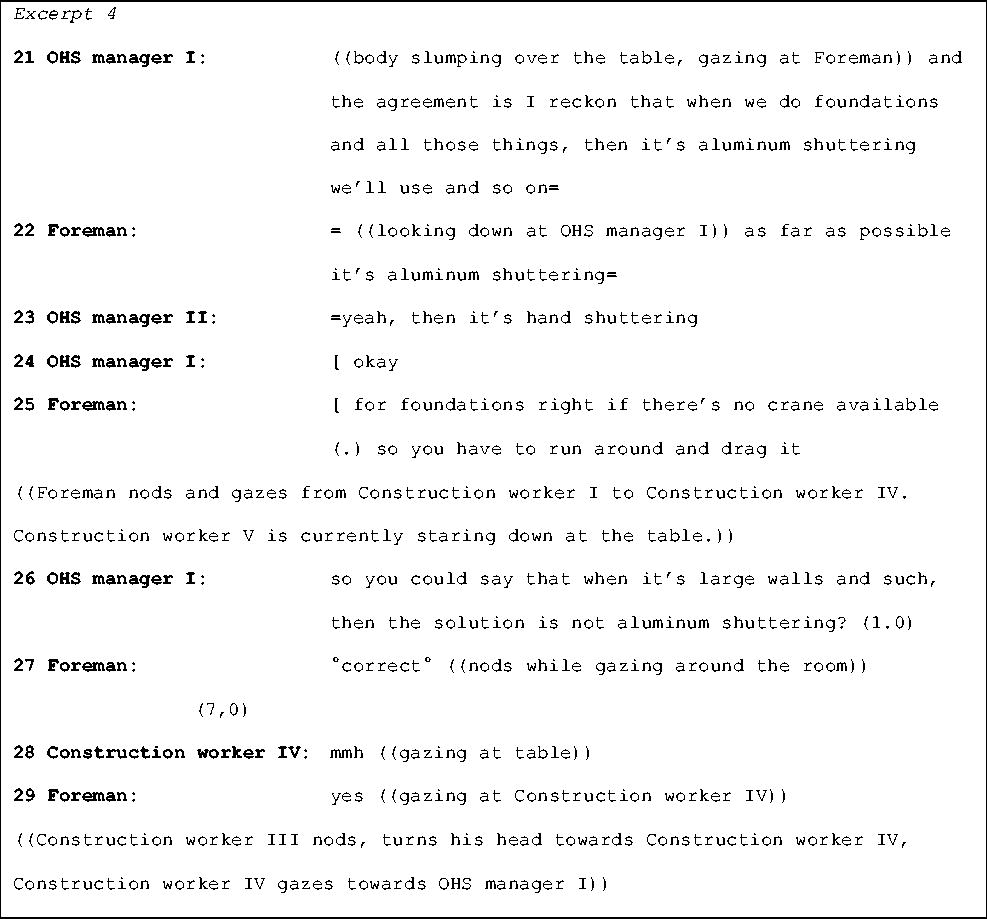
Next, OHS manager I seeks to summarise the conclusion to what just happened. In this way she pays attention to the situation that again at this point their faces are at risk; if all they have discussed and worked with is going to be disregarded this will be challenging to further progress in the workshops. At the same time, she seeks to secure a testimony from the foreman that aluminium shuttering is used whenever possible. In this way, she starts performing face-work for the facilitator, herself and the other participants, who have invested face in developing the idea of aluminium shuttering. She displays bodily signs of being in an awkward situation. Her body is slightly bent forward and she is not seeking eye contact with the foreman. This awkward position stands in contrast to her displays of enthusiasm up to retrieving Foreman. In turn 22, the foreman refuses to give a firm promise that he would later have to go back on. OHS manager II then in turn 23 repeat the foreman’s half promise. The foreman (turn 25) provides a conditional answer and thereby denies all current threats to his line of a capable and knowledgeable decision-maker.
When OHS manager I next asks if aluminium shuttering should not be used for “large walls and such” (l. 26), the question displays a strong preference for confirmation, and may be perceived as a way of defending the participants’ faces by seeking to modify the foreman’s dismissal of the aluminium suggestion. After a confirmation token from Foreman (l. 27), a long silence of seven seconds follows. Towards the end of the excerpt, Construction worker IV provides only a minimal and somewhat ambiguous alignment token while gazing at the table (l. 28), which Foreman responds to, again projecting to end this part of the discussion. Taken together, the long silence, the minimal responses and deflated body language (Clift Citation2014) leaves the impression that the discussion has all but lost its momentum. Then something happens.

On turn 30 OHS manager I formulates the upshot of the conversation so far as being that the participants should focus on “lifting techniques” and “crane capacity”. In this, OHS Manager I further elaborate on her statement in turn 26 where she suggests acceptance of the foreman’s epistemic claims. This suggestion functions to move the conversation on without further challenging the foreman’s face on the epistemic stance he is taking. This can also be seen as a piece of facework to prevent further challenging situations that could further upset the expressive order and incur further facial damage to either participants (Goffman Citation1982). However, Construction worker IV next takes some conversational “run up” (Sacks et al. Citation1974), through his “mmh” (l. 28, previous excerpt) and by audibly clicking of the pen (Stevanovic and Peräkylä Citation2014). He then takes over the turn and denies OHS manager I’s projected change of subject. At first (turn 31) he positions himself as unknowing about the issue. As such; he takes a low deontic, emotional and epistemic stance, caring to not positioning himself as an authority on the matter. However, at the same time, this also becomes a questioning at the epistemic level, as he raises doubt about the rationality of producing shuttering that would be unusable in use. This is also how we on following turns will see the foreman interpret the matter. Construction worker III, on the turn 32 supports these points with an alignment marker (“no”) and a head shake for emphasis (McClave Citation2000), thereby giving face to the line that Construction worker IV is taking. Construction worker IV is at the same time defending his own face as a capable, educated construction worker, as he earlier, before the foreman arrived, talked about his experiences with aluminium support beams. On the 33rd turn, Construction worker IV repeats and specifies his point. He further makes the extreme case formulation that” we’re not told nothing” implying that “they”, the workers, are generally in a powerless position without responsibility for this face-challenging situation. The extreme case formulation is a way of making highly unchallengeable points (Pomerantz Citation1986, Sacks Citation1995). As such, the claim that the workers are told nothing is at the same time an account for making the suggestion and a redirection of the responsibility from the workers making the suggestion to others. At the same time, it is clear that Construction worker IV, if the foreman’s statements remain unchallenged, is out of face in his line as a capable worker. This restatement and specification also implies that he is still not satisfied with the epistemic closure to this matter. Thus, while his turns are seemingly formatted as a number of concessions which acknowledge Foreman’s superior epistemic status, Construction worker IV’s framing of Foreman’s accounts as “news” also has the hearable implication that Foreman’s position is surprising. Foreman does not directly ratify Construction worker IV’s turn as a concession but rather asserts that making a large form out of aluminium would be problematic due to the “TERRIBLY many” crossbars required (another extreme case formulation: Pomerantz Citation1986), again accounting for the infeasibility of the employees’ suggestion. The provision of another account which partly acknowledges Construction worker IV’s perspective (by the softening “I will say” and by providing a more conditional rejection of his suggestion than his previous accounts) implies that Foreman orients to Construction worker IV’s turn as a challenge. By making his challenge indirect but inferable, Construction worker IV mitigates the face-threatening potential towards Foreman, while managing his own face. Interestingly, he next not only takes a downgraded epistemic stance (restating his lack of knowledge regarding the problem for a fourth time in line 35), but also outlines an asymmetry in the emotional order by, at the same time, taking a downgraded epistemic stance and his defeatist body language, which contrasts Foreman’s direct responses and dominant body language. However, while Construction worker IV is arguably doing “being out-of-face” (Sacks Citation1995), the discussion is not over yet. (at this point our analysis skips six lines of conversation concerning the characteristics of aluminium shuttering, which do not add significantly to the analysis)

In turn 37, Construction worker IV makes a new, more direct point regarding the shuttering. This is a direct challenge to the earlier epistemic claims by the foreman, again translating into the point that it makes no sense that aluminium shuttering exists and is produced unless it works. The foreman again (turn 38) states that it cannot be done on that type of wall, but then towards the end of the turn inserts “or you can but” as a weaker side remark implying that practice dictates the usage of steel. This insert or embracement is, however, disregarded from the conversation. Construction worker IV also seems not to notice it, repeating his earlier statement (turn 39). The foreman himself even disregards the insert on turn 40, and focuses on the face-saving part of Construction worker IV’s remark stating that he did not learn it at school. At this point, the foreman changes focus to the low deontic stance taken by Construction worker IV and with his” nah, nah”, he accommodates this deontic claim. By this, Construction worker IV is excused for presenting and supporting the idea. On the next turn (40) Foreman restates his claim. This is, however, followed by Construction worker IV’s sixth restatement, which shows that Construction worker IV has a hard time, letting the foreman’s epistemic claim stand. In this restatement, he points out that it would be meaningless to make the aluminium shuttering if it did not work, and as such challenges the foreman’s epistemic claim.
As Goffman (Citation1982) describes, people may show their moral infringement through restatements and challenges. This sixth restatement suggests that it offends his moral that Foreman makes a deontically based decision wrapped in an epistemic claim. Particularly Construction Worker IV and to some degree Construction worker III and OHS Manager II repeatedly poses lowered deontic stanced epistemic order questions to the foreman, perhaps seeking to invite him into a more epistemic discussion of the possibilities without threatening his face deontically. The foreman is, however, dismissive of this. In several situations, he modifies his epistemic claims that aluminium is not possible to use, while maintaining his dismissive deontic stance. This underlines an interpretation that the foreman uses his deontic status to make decisions regarding the suggested solution to the physical challenge, rather than engaging with the suggested idea and investigating the actual possibilities. On turn 42, Foreman directly addresses and puts down the challenge through emotional, epistemic and deontic means – he makes the same statement that he did before, this time with more emphasis. Foreman’s pace of talk has picked up, he now overlaps the other’s turns, and “latches” his turns closely onto Construction worker IV’s (turn 41) looking Construction worker IV directly into his eyes, indicating an aggravated stance, likely in response to the repeated epistemic challenges. He states the usage of aluminium and ends staring into the eyes of Construction worker IV, who hesitantly consents. Foreman then finishes with a”°yes°”, before formulating that the crane might not always be available (a circumstance which would support the employees’ assessment of the task as strenuous), but that this is another issue than the material of the shuttering. However, as Foreman again shifts his gaze towards the facilitator and gives up the conversational floor (as indicated by the long ensuing pause), he projects the termination of the discussion of shuttering, rather than a change of subject towards the availability of cranes.
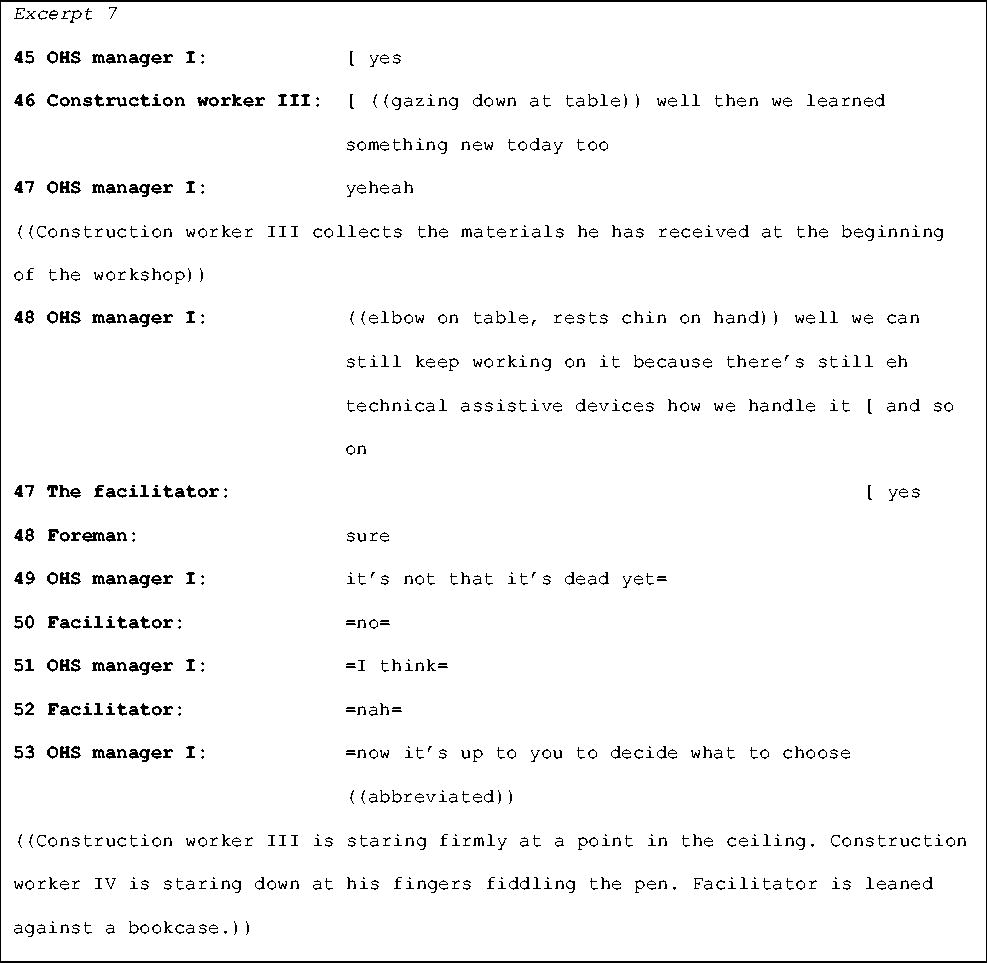
Finally, Construction worker III (turn 46) sums up a conclusion on behalf of the participants, in turn starting to repair the facial damage taken by the participants result from Foreman’s statements. His turn can be seen as speaking to all three orders, where the participants may have learned that they have no influence (deontic), something about aluminium shuttering (epistemic), and that the participants must let go of their sense of right and wrong and accept that they have nothing to say in this case (emotional). OHS manager I follows up on the face-repairing practice by suggesting that the participants focus on technical assistive devices instead (48). The facilitator agrees, and Foreman as well. Then on turn 51, OHS manager I says that the topic is not “dead”, which is very much the opposite of what the atmosphere in the room indicates. Engagement is gone. The facilitator, invested in creating solutions for the research project, conforms to OHS manager I’s remark, and she goes on to state that the field is open and now they can just choose what to go on working on. The (once) engaged workers in particular – Construction worker I, Construction worker III and Construction worker IV have, however, somewhat lost face. Not only as capable and knowledgeable workers but also as meaningful participants in the workshop and the decision making on how to work in a less physically straining way. The facilitator and OHS manager I have lost face as facilitators of meaningful participatory processes and OHS improving initiatives.
Concluding discussion
As stated, the aim of this study is to investigate how face concerns arise in the context of a participatory workshop setting, which is part of an organisational intervention concerning OHS among construction workers, and how participants navigate the overt as well as the potential threats to their public selves. The analysis shows how the participants’ efforts to maintain their face shape a critical sequence of interactions within this setting, which affects the outcome of the overall OHS intervention. While we have focussed on a sequence spanning only a few minutes of talk, it is relevant to note that in the rest of the workshop, limited attempts were made by the participants to come up with ideas, except for “paying better attention”, which earlier research has shown ineffective in decreasing physical exertion (Brandt et al. Citation2018).
By applying a CA-inspired perspective, the situation can be assessed as face-threatening in a Goffmanian sense, due to how participants orient to it. This may be legitimate organisationally, but it is devastating to the participatory process because the workers lose face in several ways. (1) They are exposed as someone, who do not know a lot about shuttering. As emphasised particularly by Construction worker IV, this is not compatible with a self-perceived status as an educated concrete worker – they did not learn at school. As such, it is incompatible with their senses of selves, and is therefore connected with discomfort for the workers, indicated by their many attempts to open up the epistemic order of the discussion. (2) They are deontically dominated by their foreman and put into place. This causes them to lose face as being treated like unruly children is incompatible with a masculine construction worker identity, which has been studied elsewhere (Wolkowitz Citation2006). (3) They may feel fooled by their own engagement in the participatory process even though they initially expressed reservations that” the high lords” would not accept anything costing money. This may cause them to feel naïve, which is again not a positive characteristic to publicly display in most lines of identity.
As Rosskam describes, one of the ambitions of participatory action research paradigms is to redistribute influence between workers and management (Rosskam Citation2009). Our study can be seen as a concrete example of how this ambition does not necessarily come easy. Investigating participatory processes on a larger scale with a similar analytical framework may contribute to explaining the mixed results of participatory OHS interventions in the construction industry (e.g. Dale et al. Citation2016, Brandt et al. Citation2018). Also, this may contribute to pinpointing, why stronger social identification with gang colleagues than with management (Andersen et al. Citation2015) is (re)configured in communicational practice. It is indeed a problem, if workers are invited to gain influence and end up losing face from engagement. Loss-of-face and disagreements have the potential to disengage employees, if they expect rejections of their suggestions or participating in the discussion, as also pointed out by Morrison (Citation2011).
Perhaps less obvious is Foreman’s risk of losing face. This is unfortunate situation may be caused by several factors. (1) He was not present during the workshop’s initial phases, where the aluminium shuttering idea was developed. As a consequence, he has not been part of the research of available products and may not feel ownership to the idea, as supported in the findings of Strumińska-Kutra (Citation2016). (2) Foreman may feel challenged because he feels his role as a competent foreman is challenged by the suggestion of alternatives to the practices he has been a part of. His ability to make decisions as a manager is threatened, which might aggravate the situation. This is not unlikely, knowing the usual managerial culture of the construction industry: as Thiel describes, management in construction is generally a highly emotional, aggressive and masculine space (Thiel Citation2012). Even though this is a known practice, it poses a problematic issue as deontic positioning may be valued higher than knowledge about solutions that may improve OHS. (3) The foreman may feel his face as a competent foreman is threatened towards hierarchically higher placed levels of management, as usual practice dictates the usage of the cheaper steel shuttering while also threatened by the fact that the company has a policy of putting OHS above profit and economic regards. This shows that participation is not unproblematic for managers either, although the tendency within the literature has been to view managers as relatively unaffected by their roles in participatory settings.
In addition, Rosskam describes that establishing relationships with both workers and managers is an important part of the research. While she suggests that overcommitting as a researcher may be problematic because the participants, both managers and employees, must be engaged and committed to any changes they decide to implement or not (Rosskam Citation2009). In the present study, the researchers had already developed a relationship with both OHS managers and the foreman. However, the study still shows how positive expectations to commitment and engagement based on this relationship may be circumvented by unexpected turns of events, and by stakeholders who change their plans at the final critical moments. What constitute a “good” or sufficient relationship between researchers and participants may be interesting to investigate. The situation affirms Beirne’s point that managerial participation in participatory research may cause problems related to employee influence (Beirne Citation2008). At the same time, it also shows the risk of not including managers as lacking shared understanding of solutions and goals from management may prevent organisational engagement as Strumińska-Kutra (Citation2016) suggests. This study contributes with insights on how to handle managers’ socio-affective engagement in the participatory process. As does it show that insisting on the participation of management at the right time in the right way is needed, if changes are to be implemented. In relation to the OHS literature, the study highlights the importance of managing the socio-affective aspect of participatory action processes. First off, our findings suggest that future research may benefit from systematically reviewing the micro-social interactions in participatory processes in order to discover the more generalisable qualities of communicational practices and their impact on the overall interventions. On a more practical note, it may be suggested that performing initial analysis of whom and how different parties may be putting their faces at risk, deontically, epistemically and emotionally, in participatory processes is viable. In this way, researchers or facilitators may be explicitly aware of the lines which the respective parties may be interested in maintaining, and may be able to take particular care in planning how they wish to support, challenge or postpone the handling of these lines. This may pose some challenges to future interventions but can also support fruitful discussions among facilitators before engaging with participatory processes. Based on this study, it would seem that facilitators could benefit from being able to question what seems to be deontically based statements, not necessarily with epistemically stronger claims, but also by pointing out epistemic uncertainties.
Importantly, the CA approach is limited in lack of focus on the context outside the particular interaction. This means that other discussions, cultural norms and participant’s rationalities, which may be based on things, they wish to achieve or maintain outside the conversation, are outside the scope of CA analyses. In order to account for such relevant on-goings, other methods have to be applied.
The interactional analyses presented here show the participants’ orientations and negotiations, and as the CA approach we employ is foreign to both the OHS and participatory literature, it provides a potential resource for theoretical refinement within these fields by engaging closely with phenomena that have thus far mostly been studied through interview and survey methods. For example, while previous studies have described that managers may hamper participatory processes by their lack openness to employees’ suggestions (Morrison Citation2011), our approach shows how Foreman’s accounts are specifically designed to “naturalize” his own position and potentially downplay the employees’ concerns. This “management of meaning” has so far received little attention in the literature, though it is likely to play an important role in how employees perceive their manager’s stance. Developing methods that turn managerial emphasis towards epistemic matters rather than deontic domination may be a way of improving future interventions and improvements regarding OHS in the construction industry.
Disclosure statement
No potential conflict of interest was reported by the author(s).
References
- Ajslev, J., et al., 2013. Habituating pain: questioning pain and physical strain as inextricable conditions in the construction industry. Nordic journal of working life studies, 3 (3), 195–218.
- Ajslev, J., et al., 2016. Trading health for money: resisting physical strain and pain as conditions in construction work. Work, employment and society, 31 (6), 887–903.
- Andersen, L.P., et al., 2015. Social identity in the construction industry: implications for safety perception and behavior. Construction management and economics, 33, 8.
- Aoki, H. 2011. Some functions of speaker head nods. In: C. Goodwin, C. LeBaron, & J. Streeck Eds. Embodied interaction: Language and the Body in the Material World (pp. 93–105). Cambridge: University Press.
- Beirne, M., 2008. Idealism and the applied relevance of research on employee participation. Work, employment & society, 22 (4), 675–693.
- Brandt, M., et al., 2015. Participatory intervention with objectively measured physical risk factors for musculoskeletal disorders in the construction industry: study protocol for a cluster randomized controlled trial. BMC musculoskeletal disorders, 16, 302.
- Brandt, M., et al., 2018. Effects of a participatory ergonomics intervention with wearable technical measurements of physical workload in the construction industry: cluster randomized controlled trial. Journal of medical internet research, 20 (12), e10272.
- Clift, R., 2014. Visible deflation: embodiment and emotion in interaction. Research on language and social interaction, 47 (4), 380–403.
- Dale, A.M., et al., 2016. Evaluation of a participatory ergonomics intervention in small commercial construction firms. American journal of industrial medicine, 59 (6), 465–475.
- Flyvbjerg, B., 2006. Five misunderstandings about case-study research. Qualitative inquiry, 12 (2), 219–245.
- Garfinkel, H., 1967. Studies in ethnomethodology. Cambridge: Polity.
- Gluch, P. and Räisänen, C., 2009. Interactional perspective on environmental communication in construction projects. Building research & information, 37 (2), 164–175.
- Goffman, E., 1982. Interaction ritual – essays on face-to-face behavior. 1st ed. New York: Pantheon.
- Gustavsen, B. and Engelstad, P.H., 1986. The design of conferences and the evolving role of democratic dialogue in changing working life. Human relations, 39 (2), 101–116.
- Heath, C. 1992. Gesture’s discreet tasks: Multiple relevancies in visual conduct and in the contextualisation of language. In: P. Auer & A. DiLuzio, Eds. The Contextualization of Language (pp. 101–128). John Benjamins Publishing Company.
- Heritage, J., 1988. Explanations as accounts: a conversation analytic perspective. In: C. Antaki, ed. Analysing everyday explanation. A casebook of methods. London: SAGE, 127–144.
- Heritage, J. 2012. Epistemics in action: Action formation and territories of knowledge. Research on Language & Social Interaction, 45 (1), 1–29.
- ILO, 2001. Guidelines on occupational safety and health management systems (ILO-OSH 2001). International Labor Organization. Available at: http://www.ilo.org
- Jefferson, G., 2004. Glossary of transcript symbols with an introduction. Pragmatics and beyond new series, 125, 13–34.
- Kompier, M., et al., 1998. Cases in stress prevention: the success of a participative and stepwise approach. Stress medicine, 14 (3), 155–168.
- Lerner, G.H., 1996. Finding “face” in the preference structures of talk-in-interaction. Social psychology quarterly, 59 (4), 303–321.
- Lerner, G. H. 2003. Selecting next speaker: The context-sensitive operation of a context-free organization. Language in Society, 32 (2), 177–201. https://doi.org/10.1017/S004740450332202X
- Lingard, H., 2013. Occupational health and safety in the construction industry. Construction management and economics, 31, 6.
- Lingard, H., et al., 2015. Looking and learning: using participatory video to improve health and safety in the construction industry. Construction management and economics, 33, 9.
- Llewellyn, N. and Hindmarsh, J., 2013. The order problem: inference and interaction in interactive service work. Human relations, 66 (11), 1401–1426.
- Local, J. and Walker, G., 2008. Stance and affect in conversation: on the interplay of sequential and phonetic resources. Text & talk – an interdisciplinary journal of language, discourse communication studies, 28 (6), 723–747.
- MacKay, C.J., et al., 2004. Management standards’ and work-related stress in the UK: policy background and science. Work & stress, 18 (2), 91–112.
- McClave, E.Z., 2000. Linguistic functions of head movements in the context of speech. Journal of pragmatics, 32 (7), 855–878.
- Mikkelsen, A., 2005. Methodological challenges in the study of organizational interventions in flexible organizations. In: Anthology for Kjell Grønhaug in celebration of his 70th birthday. Bergen, Norway: Fagbokforlaget, 151–178.
- Mogendorff, K., 2016. The building or enactment of expertise in context: what the performative turn in the social sciences may add to expertise research in construction management. Construction management and economics, 34 (7–8), 484–491.
- Mondada, L., 2007. Commentary: transcript variations and the indexicality of transcribing practices. Discourse studies, 9 (6), 809–821.
- Morrison, E.W., 2011. Employee voice behavior: integration and directions for future research. Academy of management annals, 5 (1), 373–412.
- Nielsen, K.A., and Svensson, L.G., eds. 2006. Action research and interactive research: beyond practice and theory. Maastricht: Shaker Publishing B.V.
- Nielsen, K. and Randall, R., 2012. The importance of employee participation and perceptions of changes in procedures in a teamworking intervention. Work & stress, 26 (2), 91–111.
- Nielsen, K., Randall, R., and Albertsen, K., 2007. Participants’ appraisals of process issues and the effects of stress management interventions. Journal of organizational behavior, 28 (6), 793–810.
- Nielsen, K., Taris, T.W., and Cox, T., 2010. The future of organizational interventions: addressing the challenges of today’s organizations. Work & stress, 24 (3), 219–233.
- Paap, K., 2006. Working construction - why white working-class men put themselves -and the labor movement- in Harm’s way. Ithaca, NY: Cornell University Press.
- Peräkylä, A. and Sorjonen, M.-L., 2012. Emotion in interaction. Oxford: Oxford University Press.
- Pomerantz, A., 1984. Agreeing and disagreeing with assessments: some features of preferred/dispreferred turn shapes. In: J.M. Atkinson and J. Heritage, eds. Structures of social action: studies in conversations analysis. Cambridge: Cambridge University Press.
- Pomerantz, A., 1986. Extreme case formulations: a way of legitimizing claims. Human studies, 9 (2), 219–229.
- Rivilis, I., et al., 2008. Effectiveness of participatory ergonomic interventions on health outcomes: a systematic review. Applied ergonomics, 39 (3), 342–358.
- Rosskam, E., 2009. Using participatory action research methodology to improve worker health. In: P.L. Schnall, M. Dobson, and E. Rosskam, eds. Unhealthy work: causes, consequences, cures. New York: Baywood Publishing Company, 211–229.
- Ruusuvuori, J. 2007. Managing affect: Integration of empathy and problem-solving in health care encounters. Discourse Studies, 9 (5), 597–622.
- Ruusuvuori, J., 2012. Emotion, affect and conversation. In: J. Sidnell and T. Stivers, eds. The handbook of conversation analysis. Chichester: John Wiley & Sons, Ltd, 330–349.
- Sacks, H., Schegloff, E. A., and Jefferson, G. 1974. A simplest systematics for the organization of turn-taking for conversation. Language, 50 (4), 696–735.
- Sacks, H., 1987. On the preferences for agreement and contiguity in sequences in conversation. In: G. Button and J.R.E. Lee, eds. Talk and social organisation. Clevedon, England: Multilingual Matters, 54–69.
- Sacks, H., 1995. Lectures on conversation. Volumes I and II ed. In: G. Jefferson and E.A. Schegloff, eds. Oxford: Wiley-Blackwell.
- Samra-Fredericks, D., 2010. Ethnomethodology and the moral accountability of interaction: navigating the conceptual terrain of ‘face’ and face-work. Journal of pragmatics, 42 (8), 2147–2157.
- Schegloff, E.A., 1997. Whose text? Whose context? Discourse & society, 8 (2), 165–187.
- Schegloff, E.A. and Sacks, H., 1973. Opening up closings. Semiotica, 8, 289–327.
- Stevanovic, M., 2015. Displays of uncertainty and proximal deontic claims: the case of proposal sequences. Journal of pragmatics, 78, 84–97.
- Stevanovic, M. and Peräkylä, A., 2014. Three orders in the organization of human action: on the interface between knowledge, power, and emotion in interaction and social relations. Language in society, 43 (2), 185–207.
- Strumińska-Kutra, M., 2016. Engaged scholarship: steering between the risks of paternalism, opportunism, and paralysis. Organization, 23 (6), 864–883.
- Thiel, D., 2012. Builders – class, gender and ethnicity in the construction industry. London: Routledge.
- van Eerd, D., et al., 2010. Process and implementation of participatory ergonomic interventions: a systematic review. Ergonomics, 53 (10), 1153–1166.
- Wolkowitz, C., 2006. Bodies at work. London: SAGE Publications Ltd.

